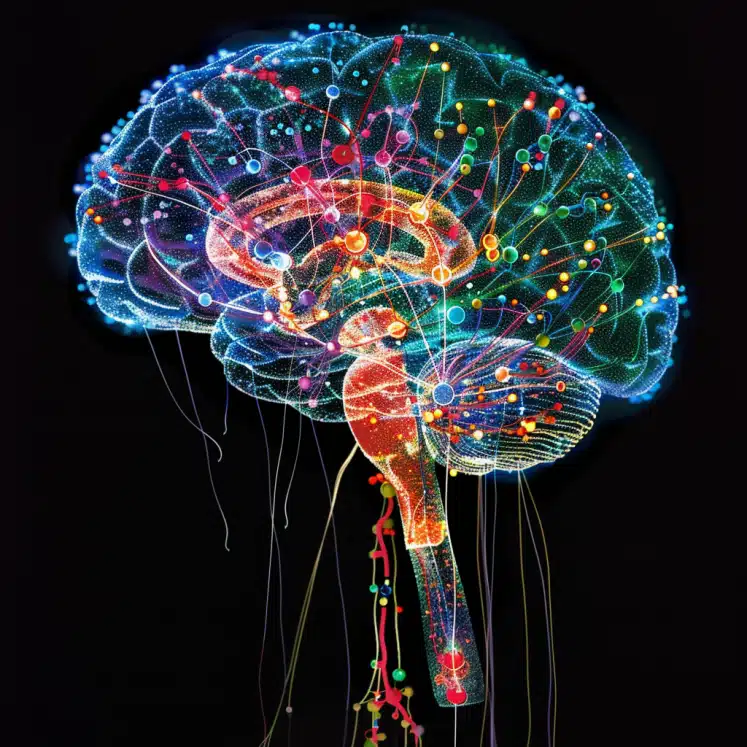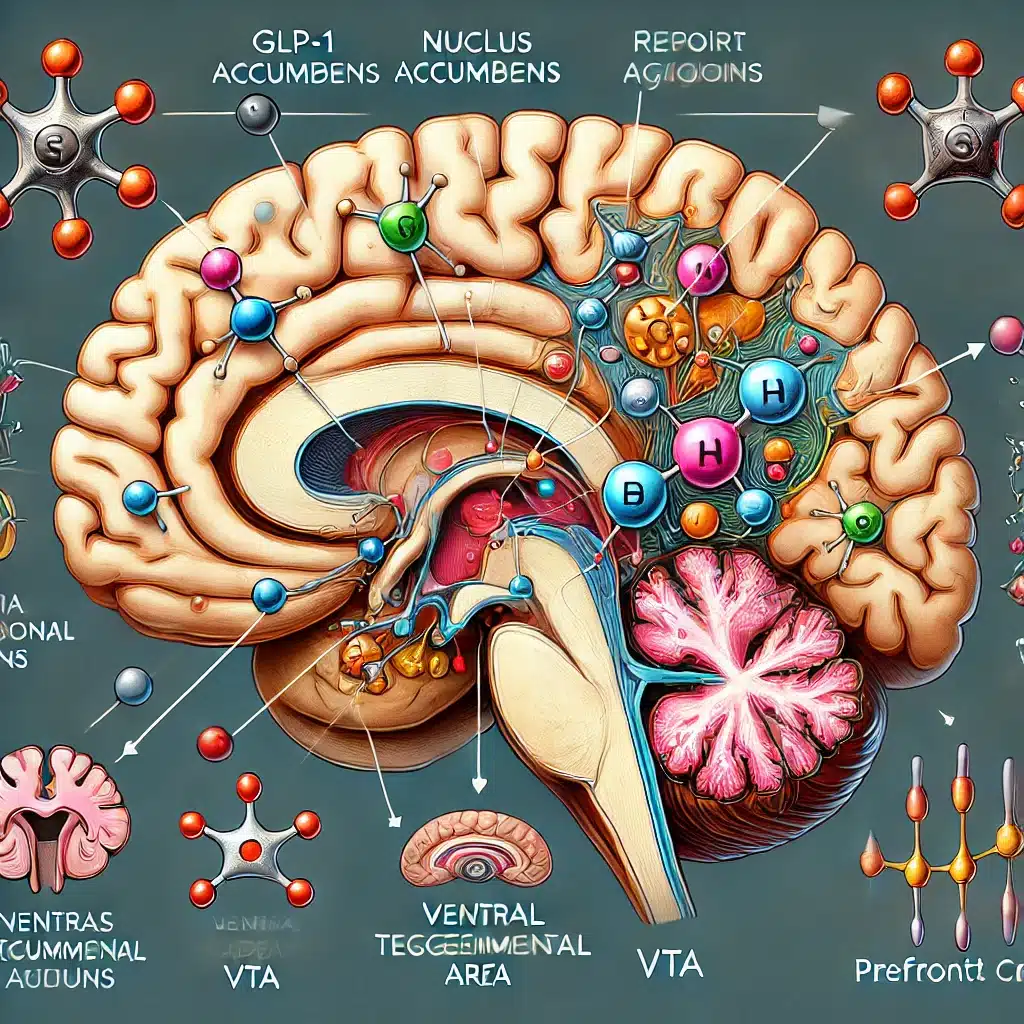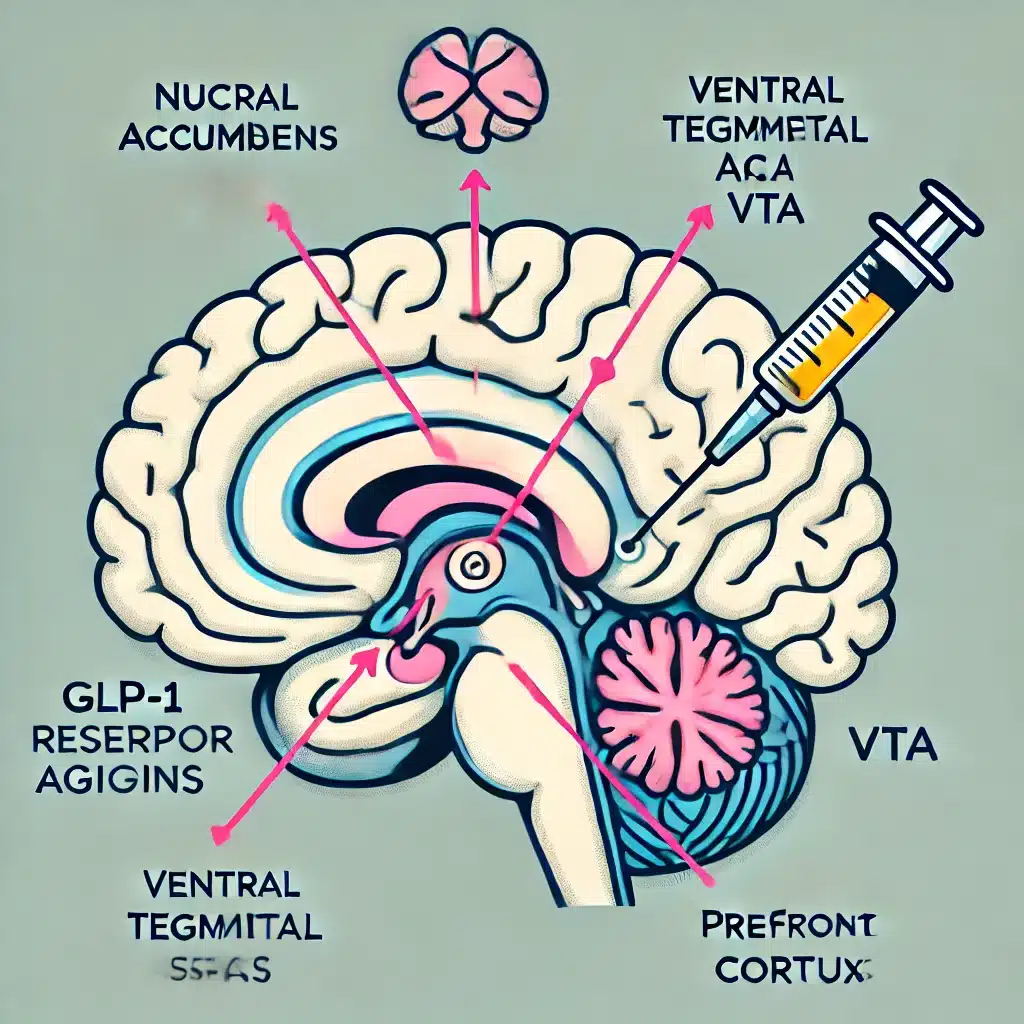GLP-1 receptor agonists (GLP-1RAs) show promise in regulating the reward system and potentially treating motivation and reward-processing disorders.
Highlights:
- Regulation of Reward System Dysfunction: GLP-1RAs influence the brain’s reward system, which is involved in behaviors related to food and substance use.
- Brain Activation: These agonists affect brain regions differently in individuals ranging from lean to obese, impacting responses to food and high-calorie images.
- Reduced Energy Intake: GLP-1RAs consistently lead to decreased energy intake and lower caloric consumption by affecting hunger and satiety levels.
- Dopaminergic Signaling: They may normalize insulin resistance and modulate dopamine-related signaling, which can reduce anhedonia and improve reward-related behaviors.
- Potential Therapeutic Uses: The findings suggest potential applications for GLP-1RAs in treating disorders involving motivation and reward-processing, such as addiction and mood disorders.
Source: Physiology & Behavior (2024)
Major Findings: GLP-1RAs & Reward System (2024)
1. Regulation of Reward System Dysfunction
Role of GLP-1RAs: GLP-1 receptor agonists (GLP-1RAs) help regulate dysfunctions in the brain’s reward system. This is crucial for understanding behaviors linked to food intake and substance use.
Mechanism: These drugs mimic the hormone GLP-1, which influences insulin and glucagon secretion, slowing gastric emptying and increasing feelings of fullness.
2. Effects on Brain Activation
Brain Regions: GLP-1RAs affect specific brain regions, including the hypothalamus, parietal cortex, and orbitofrontal cortex, which are associated with the reward system.
Obesity & Food Cues: In obese individuals, these drugs reduce brain activation in response to high-calorie food images, potentially decreasing the desire for such foods.
3. Reduction in Energy Intake
Decreased Appetite: GLP-1RAs consistently lower energy intake by reducing appetite and increasing satiety. This leads to a significant decrease in caloric consumption.
Clinical Evidence: Multiple studies have shown that these drugs help manage appetite and reduce overall food intake, aiding in weight loss and improved dietary control.
4. Modulation of Dopaminergic Signaling
Dopamine & Reward: GLP-1RAs may help normalize insulin resistance, which can enhance dopamine signaling in the brain. This is important because dopamine is a key neurotransmitter involved in experiencing pleasure and motivation.
Anhedonia: By improving dopamine signaling, GLP-1RAs can potentially reduce anhedonia (the inability to feel pleasure), which is common in conditions like obesity and type 2 diabetes.
5. Potential Therapeutic Applications
Broader Use in Disorders: Beyond treating diabetes and obesity, GLP-1RAs show promise in addressing various motivation and reward-processing disorders.
Addiction and Mood Disorders: These drugs may be useful in treating addiction and mood disorders by modulating reward-related behaviors and improving overall motivation.
6. Detailed Insights
Study Methods: Researchers followed rigorous protocols, including randomized controlled trials and fMRI scans, to assess brain responses and behavioral changes.
Impact on Obese Individuals: Obese individuals showed significant changes in brain activation patterns when treated with GLP-1RAs, indicating a direct impact on how the brain processes reward signals related to food.
Food vs. Monetary Rewards: Studies found that GLP-1RAs influenced the effort individuals were willing to exert for different types of rewards, with notable effects on both food and monetary rewards.
Cravings and Eating Control: Patients treated with GLP-1RAs reported better control over cravings and reduced preference for high-fat, high-calorie foods, highlighting the drugs’ potential in managing unhealthy eating habits.
How GLP-1 Receptor Agonists May Help Reward Processing in the Brain (Possible Mechanisms)

1. Modulation of Dopaminergic Signaling
Dopamine Enhancement: GLP-1RAs can normalize insulin resistance, which in turn can enhance dopaminergic signaling. Dopamine is crucial for reward processing, pleasure, and motivation.
Improved Pleasure Response: By enhancing dopamine function, GLP-1RAs may reduce anhedonia (the inability to feel pleasure), which is often associated with conditions like obesity and type 2 diabetes.
2. Influence on Brain Activation
Brain Regions: GLP-1 receptors are present in key brain areas involved in reward processing, such as the hypothalamus, parietal cortex, orbitofrontal cortex, and insula.
Reduced Activation: Treatment with GLP-1RAs has been shown to reduce activation in these regions when exposed to high-calorie food cues, which may decrease the desirability of such foods and help control food intake.
3. Regulation of Appetite & Satiety
Appetite Suppression: GLP-1RAs slow gastric emptying, leading to increased feelings of fullness and reduced appetite. This can result in lower caloric intake and better control over eating habits.
Hormonal Effects: These drugs mimic the GLP-1 hormone, which plays a role in regulating hunger and satiety signals, further contributing to reduced food intake and improved weight management.
4. Interaction with Reward Pathways
Hippocampus & Nucleus Accumbens: GLP-1RAs enhance neurogenesis in the hippocampus and modulate synaptic strength in the nucleus accumbens, both critical areas for learning and reward processing.
Cortical Activation: The reduction in cortical activation in response to rewarding stimuli helps mitigate excessive reward-driven behaviors, such as overeating or substance use.
5. Impact on Insulin Sensitivity
Normalization of Insulin Levels: By improving insulin sensitivity, GLP-1RAs help stabilize blood sugar levels, which can influence reward-related behaviors by reducing cravings and improving overall metabolic health.
Dopaminergic Function: Improved insulin signaling can enhance dopamine synthesis and turnover, thereby improving reward and motivational processes.
6. Reduction of Cravings & Better Eating Control
Cravings Management: Studies have shown that GLP-1RAs can reduce cravings for high-calorie and high-fat foods, leading to better control over eating and healthier food choices.
Behavioral Adaptation: By influencing brain activation patterns and reducing cravings, GLP-1RAs help individuals adapt their behavior to more healthful eating habits, which can be particularly beneficial for those with binge eating disorder or obesity.
Future Potential: GLP-1RAs to Treat Reward-Related Mental Disorders

1. Reward Dysfunction & Motivation
GLP-1RAs improve insulin sensitivity, which in turn enhances dopamine signaling.
This improvement can help alleviate anhedonia, a common symptom in many neuropsychological disorders, by increasing the ability to experience pleasure and motivation.
These drugs can reduce cravings and impulsive behaviors associated with reward dysfunctions.
By decreasing the brain’s reward response to high-calorie foods and addictive substances, GLP-1RAs can help individuals better control their consumption habits.
2. Mood Disorders
Adjunct Therapy for Depression
GLP-1RAs could be used alongside traditional antidepressants to enhance treatment outcomes.
Their ability to modulate reward pathways can help address motivational deficits and improve mood in individuals with depression.
Treating Anhedonia
By enhancing dopaminergic signaling, GLP-1RAs can specifically target anhedonia, making it easier for individuals with mood disorders to experience pleasure and engage in rewarding activities.
3. Addiction & Substance Use Disorders
Craving Reduction
GLP-1RAs have shown potential in reducing cravings for addictive substances such as alcohol and nicotine.
This can make it easier for individuals to quit and maintain abstinence.
Relapse Prevention
By stabilizing dopamine levels and reducing the reward response to substances of abuse, GLP-1RAs can help prevent relapse in recovering addicts.
4. Cognitive & Neurodegenerative Disorders
Neuroprotection
GLP-1RAs have neuroprotective properties that can help in conditions like Alzheimer’s disease.
They enhance neurogenesis and protect against cognitive decline by improving insulin sensitivity and reducing inflammation in the brain.
Cognitive Enhancement
These drugs could be used to improve cognitive function in individuals with neurodegenerative disorders, potentially slowing the progression of diseases like Alzheimer’s.
Review Details: GLP-1RAs & Reward-Related Behaviors (2024)
The goal of this review paper from Sebastian Badulescu et al. was to systematically examine the existing evidence on the effects of Glucagon-like peptide 1 receptor agonists (GLP-1RAs) on the brain’s reward system and their potential therapeutic applications for motivation and reward-related behavioral disturbances.
Methods
- Search Strategy: The review followed PRISMA guidelines and included comprehensive searches in databases like OVID, PubMed, Scopus, and Google Scholar.
- Inclusion Criteria: Only human studies focusing on reward behavior and GLP-1RAs were included. Articles needed to be full-text, in English, and related to clinical populations.
- Screening Process: Two independent reviewers screened titles, abstracts, and full texts to select relevant studies. Data extraction covered study characteristics, outcomes related to reward behaviors, and quality assessments based on NIH guidelines.
Data
- Number of Studies: The review included 15 studies out of an initial 600 articles identified through database searches and additional manual searches.
- Study Types: The selected studies were randomized controlled trials, crossover trials, and pilot studies.
- Population: Participants varied from lean to obese individuals, including those with type 2 diabetes, binge eating disorder, and alcohol use disorder.
- Data Points: Key data extracted included sample sizes, population descriptions, study aims, methodologies, outcome characteristics, and significance of findings.
Limitations
- Focus on Specific Reward Behaviors: The review mainly focused on food and substance reward behaviors, potentially overlooking other forms of reward-related behaviors.
- Heterogeneity of Studies: Variability in study designs, sample sizes, and methodologies may affect the generalizability of the findings.
- Lack of Long-term Data: Many studies did not provide long-term follow-up data, limiting the understanding of sustained effects of GLP-1RAs on reward systems.
- Bias Risk: Some studies had a medium risk of bias due to insufficient descriptions of blinding and intervention procedures, which could influence the results.
Conclusion: GLP-1RAs for Reward System Dysfunction
References
- Study: Glucagon-like peptide 1 agonist and effects on reward behaviour: A systematic review (2024)
- Authors: Sebastian Badulescu et al.







